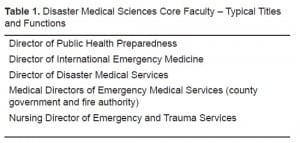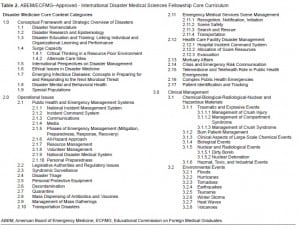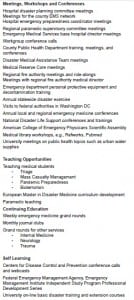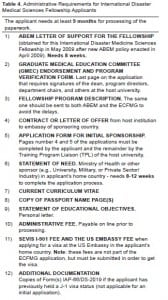| Author | Affiliation |
|---|---|
| Kristi L. Koenig, MD | University of California Irvine School of Medicine, Department of Emergency Medicine, Orange, CA |
| Tareg Bey, MD | University of California Irvine School of Medicine, Department of Emergency Medicine, Orange, CA |
| Carl H. Schultz, MD | University of California Irvine School of Medicine, Department of Emergency Medicine, Orange, CA |
ABSTRACT
As recent events highlight, a global requirement exists for evidence-based training in the emerging field of Disaster Medicine. The following is an example of an International Disaster Medical Sciences Fellowship created to fill this need. We provide here a program description, including educational goals and objectives and a model core curriculum based on current evidence-based literature. In addition, we describe the administrative process to establish the fellowship. Information about this innovative educational program is valuable to international Disaster Medicine scholars, as well as U.S. institutions seeking to establish formal training in Disaster Medical Sciences.
INTRODUCTION
There is a need for international training in Disaster Medical Sciences. Scholars and health policy makers from some regions of the world may have limited access to cutting-edge training in the emerging field of Disaster Medicine. It is critical to use the best science and evidence-based approaches available when training future leaders in this field. To this end, a diverse core faculty of Disaster Medical Sciences academicians (Table 1) has developed a formal program for international applicants seeking training in Disaster Medicine.1 Requirements include the following: the sponsoring country must confirm the need for qualified practitioners, and the applicant must describe how the skills and knowledge gained during the fellowship could be applied to improve future disaster management in the home country. To assist potential international Disaster Medical Sciences scholars and U.S.-based educational institutions that wish to engage in similar training programs, this paper provides a detailed description of the program, key considerations for its establishment, and a model core curriculum. The same Disaster Medical Sciences Fellowship is established and available for U.S. applicants; however, U.S. candidates are not subject to sponsorship and visa requirements.

Disaster Medicine is a global issue. In managing disasters of all types and sizes, it is desirable to use a broad-based all-hazard, comprehensive emergency management approach that includes assessments of worldwide challenges and variable approaches to their solutions. In order to establish Disaster Medicine as a distinct academic discipline, a unique body of knowledge must be demonstrated. Textbooks and definitive references2,3,4,5 have emerged and are one of the criteria. Fellowships are an additional element needed to form the basis of a unique academic discipline. While several Disaster Medicine Fellowships exist,6 few have focused on international applicants or disaster medicine specifically.7
FELLOWSHIP OVERVIEW
Introduction
The emergency department (ED) offers a one- to two-year post-graduate fellowship in Disaster Medical Sciences to U.S. and international physicians. The Fellowship Year 1 covers the core curriculum. The optional Fellowship Year 2 is for applicants who wish to pursue a Masters of Public Health and more in-depth research and training in Disaster Medical Sciences. Participants in the two-year fellowship program may choose to begin Masters work during their first year of training. It is anticipated that most applicants will complete the two-year program.
Demand for Training
For international applicants, the sponsoring country must confirm in writing the need for qualified practitioners in Disaster Medicine. The applicant must describe how the skills and knowledge gained during the fellowship will be applied to improve future disaster management in the home country.
Funding
The sponsoring country of the applicant is responsible for all salary, tuition, and expenses, including insurance and benefits, related to the fellowship. An official letter is required of the applicant to confirm this coverage for the duration of the fellowship period.
Institutional Resources
Full access to the resources of the university is provided to the successful applicant. This includes library and internet resources, access to training and simulation materials, office space, statistical support for research, and access to administrative and educational meetings and multidisciplinary faculty including nurse disaster experts. In addition, the applicant will have access to the county Emergency Medical Services Agency and the county Fire Authority as off-site resources. The university hospital is a Level I trauma center, burn center, cardiac center and stroke receiving center with a well-established emergency medicine residency and traditional (domestic) disaster medicine fellowship program.
DETAILS OF THE TRAINING PROGRAM
Educational Goals and Objectives
The educational goals and objectives of the Fellowship are to acquire the knowledge and skills related to Disaster Medical Sciences and to implement those skills with the aim of improving the home country’s level of preparedness (both national and hospital-based) for critical incidents and disasters. To achieve this overriding objective, the following are specific goals:
Clinical
-
Gain expertise in treating trauma patients with penetrating injuries and blast injuries
-
Learn and master how to evaluate and manage hazardous materials casualties
-
Improve knowledge of procedures and clinical skills by close observation in the ED, e.g., trauma patients with penetrating injuries (gunshot wounds), blast injuries, hazardous materials casualties
-
Obtain expertise in mass casualty triage
-
Acquire skills in the evaluation of trauma patients with penetrating and blast injuries
-
Learn to diagnose and manage hazardous materials casualties
-
Master mass causality and large-scale event management
-
Gain skills in post mass casualty management, planning, reevaluation of resources, preparing for a second surge and utilizing the data and the experiences gained to improve future responses and research
Administrative
-
Acquire skills in regional emergency response plans and concept of operations
-
Learn prehospital and hospital-based management of mass casualty incidents from both conventional and chemical-biological-radiological-nuclear causes
-
Gain skills in developing and participating in a minimum of two large-scale disaster preparedness exercises, each focusing specifically on prehospital and hospital responses
-
Develop the skills to understand and apply the National Incident Management System
Research
-
Understand the fundamentals of disaster research including the unique characteristics that separate it from traditional research approaches
-
Compare and contrast the pros and cons of disaster research methodologies
-
Critically analyze existing disaster literature
-
Develop proposals for important research questions for the future of Disaster Medical Sciences
Prehospital
-
Learn how triage systems work
-
Understand casualty flow management and tracking and the use of novel devices
-
Gain familiarity with communications systems and casualty-dispatch management in mass casualty incidents
-
Develop knowledge of unique hazards and scene safety during disasters
Hospital
-
Learn how the Hospital Incident Command System functions
-
Describe hospital decontamination protocols for chemical, biological and radiological hazards
-
Understand the principles of maximizing hospital surge capacity
-
Develop skills in the allocation of scarce resources after a disaster
CORE CURRICULUM
The Disaster Medical Sciences Core Curriculum is based on the experience of the developers (including academic and government), review of existing professional organizations’ committee products, and definitive disaster medicine references. As outlined in Table 2, the core content categories are divided into a Conceptual Framework and Strategic Overview of Disasters (including terminology), Operational Issues, and Clinical Management. This Core Curriculum was submitted to the American Board of Emergency Medicine (ABEM) and the Accreditation Council for Graduate Medical Education (ACGME) as part of the approval process for the Fellowship (see below).

DESCRIPTION OF REQUIRED ROTATIONS
Sample educational and learning opportunities and activities are listed in Table 3. Specific rotations include:

University Medical Center and Campus
Clinical
Participate in patient care and management discussions on rounds, at morbidity and mortality conferences, and at journal clubs as related to Disaster Medical Sciences. Engage in interactive discussions and training sessions with experienced Professors of Emergency Medicine. At the end of this rotation, the candidate will have gained an understanding of triage and clinical management of disaster casualties including those from chemical, biological, radiological/nuclear, and blast/high explosive causes.
Research
Study the fundamentals of disaster research and the unique characteristics of disaster research methodologies. Critically analyze existing disaster literature and present critiques at conferences and journal clubs. Develop proposals for important cutting-edge disaster research questions. At the end of this rotation, the candidate will have gained an understanding of the unique issues surrounding disaster research, limitations of current published data, and critical areas for future exploration.
Teaching
Develop and deliver didactic, interactive, and hands-on sessions for medical students, residents, and nurses involved with disaster management. Participate in training for disaster drills and disaster preparedness including the Hospital Incident Command System, personal protective equipment, and decontamination procedures. At the end of this rotation, the candidate will have gained experience with teaching multidisciplinary groups of disaster healthcare providers using various teaching methodologies.
Administrative
Coordinate input to hospital and university committees and task forces for disaster planning based on a regional hazard vulnerability analysis. Participate in protocol development using evidence-based methodologies. Work with the University-wide Program in Public Health, including campus-associated research centers such as the Urban Water Research Center, and the Nursing Administration to address critical disaster management issues. At the end of this rotation, the candidate will have gained critical thinking skills and practical experience in addressing cutting-edge disaster challenges for healthcare systems.
Off-site
Emergency Medical Services and Fire Authority
Attend meetings, participate in drills and evaluate protocols. One-on-one experience with the county Fire Authority Medical Director, visits to the Emergency Operations Center, and paramedic ride-alongs. At the end of this rotation, the candidate will have gained experience in managing prehospital disaster scenarios.
Public Health
Participate in planning activities, evaluate strategies for public health preparedness, and recognize cutting-edge public health threats. One-on-one experience with the Medical Director, Emergency Medical Services, County Health Care Agency and evaluation of incident management systems for public health. At the end of this rotation, the candidate will have an understanding of the role public health plays in disasters and have gained enhanced knowledge of public health emergency systems and management.
Disaster Management Systems
Evaluate local, regional, state and national systems for disaster management, inter and intra-agency communications, and cross-cutting issues. One-on-one experience with the Director of Emergency and Trauma Services, Disaster Medical Assistance Team, stockpiling and antidote strategies and planning, and surge capacity approaches. At the end of this rotation, the candidate will have gained knowledge of approaches to organizing disaster response at all levels and experience in allocation of scarce resources during a disaster.
State Activities
Participate in statewide advisory group planning meetings and related action items. One-on-one experience with the state senior health advisor for disaster management and analysis of disaster planning approaches. At the end of this rotation, the candidate will have gained experience in statewide approaches to disaster management including barriers and opportunities.
Disaster Congresses
Attend symposia, meetings, and congresses related to disaster medicine. Participate in the National American College of Emergency Physicians Scientific Assembly Disaster Committee and Disaster Section Meetings and attend short courses related to disaster medicine. Meetings with national leaders in disaster medicine will be facilitated by the fellowship director. At the end of this rotation, the candidate will have gained national level perspectives and understand variable strategies and operational approaches to disaster management.
Federal Government (second year of program)
Evaluate federal systems for disaster management and participate in one-on-one meetings with key government officials in Washington, DC including at the Office of the Assistant Secretary for Public Health Preparedness and Response, Health and Human Services; Office of Health Affairs and Federal Emergency Management Agency, Department of Homeland Security; the Institute for Global and Regional Readiness,8 and the Institute of Medicine. At the end of this rotation, the candidate would be able to demonstrate an understanding of federal disaster management systems and explain critical gaps in the federal management of catastrophic disasters.
International (second year of program)
Participate in health policy advisory groups (such as the German Institute for Emergency Medicine),9 research centers (such as the Israeli Ben Gurion Center for Research of Preparedness and Response to Emergencies and Disasters),10 and teaching via the European Master in Disaster Medicine.11 At the end of this rotation, the candidate will have gained knowledge regarding various international approaches to disaster management, established relationships with internationally renowned disaster researchers, and acquired an understanding of distance learning approaches to international teaching.
Masters of Public Health (completed in the second year of the program)
Complete rigorous course work and a publishable thesis for the university’s public health program. At the end of this rotation, the candidate will have gained the ability to solve public health problems in disasters by applying professional multi-disciplinary approaches and methods in a specialized environment such as local, state or national public health agencies and health care organizations.
SKILLS DEVELOPMENT
A variety of methods are used to develop the applicant’s skills. These include:
-
Didactic sessions (e.g., attend weekly emergency medicine grand rounds, participate in medical student disaster training sessions)
-
Hands-on training sessions (disaster simulations and drills)
-
Distance learning over the internet
-
Exposure to clinical management of disaster casualties
-
Master current disaster literature – attend monthly journal clubs
-
Assigned readings and discussion of chapters in Koenig and Schultz’s Disaster Medicine: Comprehensive Principles and Practices published by Cambridge University Press, Sponsored by the American College of Emergency Physicians, Foreward by Dr. Richard Carmona, 17thSurgeon General of the United States.2,12
-
Attend and participate in disaster health policy meetings and forums at hospital, county, statewide and national levels
-
Perform “action item” assignments from disaster task forces that address current threats
SKILLS DEVELOPMENT
A variety of methods are used to develop the applicant’s skills. These include:
-
Didactic sessions (e.g., attend weekly emergency medicine grand rounds, participate in medical student disaster training sessions)
-
Hands-on training sessions (disaster simulations and drills)
-
Distance learning over the internet
-
Exposure to clinical management of disaster casualties
-
Master current disaster literature – attend monthly journal clubs
-
Assigned readings and discussion of chapters in Koenig and Schultz’s Disaster Medicine: Comprehensive Principles and Practices published by Cambridge University Press, Sponsored by the American College of Emergency Physicians, Foreward by Dr. Richard Carmona, 17thSurgeon General of the United States.2,12
-
Attend and participate in disaster health policy meetings and forums at hospital, county, statewide and national levels
-
Perform “action item” assignments from disaster task forces that address current threats
OPTION FOR TWO-YEAR TRAINING
In order to extend the training to two years, satisfactory progress and a progression of activities must be demonstrated. Requirements include:
-
Successful completion of the first year of Fellowship training
-
Masters of Public Health course work
-
Disaster Medical Sciences publishable research project
-
Additional Rotations
-
Federal Government (Department of Homeland Security, Federal Emergency Management Agency, Department of Health and Human Services, Office of the Assistant Secretary for Public Health Preparedness and Response, Agency for Healthcare Research and Quality)
-
World Association of Disaster and Emergency Medicine
-
European Master in Disaster Medicine
-
International Disaster Conferences – presentation of research and participation in health policy committees and task forces
-
EVALUATION METHODS
A rigorous method of evaluation includes the following:
-
Daily communications with Fellowship director
-
Weekly meetings with core faculty to evaluate progress
-
Successful completion of research project on disaster medicine topic
-
Twice yearly formal evaluations and feedback from Fellowship Director
PROCESS TO ESTABLISH AN INTERNATIONAL DISASTER MEDICAL SCIENCES FELLOWSHIP AT A U.S. ACADEMIC INSTITUTION
While an alternate body (the American Board of Physician Specialists) provides board certification for Disaster Medicine,13 ABEM, a mainstream accrediting body and one of the 24 medical certification boards recognized by the American Board of Medical Specialties, does not currently recognize Disaster Medicine as a subspecialty. The International Disaster Medical Sciences Fellowship is therefore classified as a non-standard training program per the Accreditation Council for Graduate Medical Education (ACGME), subject to a number of requirements.14 The American Board of Emergency Medicine (ABEM) updated their policy in April 2009 to allow for approval of non-standard fellowships.15 A J-1 visa is necessary for entrance into the United States for such non-standard educational experiences. Because the fellowship is non-standard, the process to issue a J-1 student exchange visa through the Educational Commission for Foreign Medical Graduates (ECFMG) is different than the much simpler procedure followed for an accredited fellowship, such as toxicology or sports medicine.
The prospective foreign medical applicant must complete an application that includes specific documentation requirements to be eligible for sponsorship for a visa from the ECFMG. The ECFMG is the only entity permitted to provide a J-1 visa. Once the applicant successfully completes the application process, the ECFMG issues a one-year visa. This must be renewed if the candidate remains for an additional year. The renewal process should be started about 6 months prior to the end of the first year.
In addition to paperwork from the applicant, the sponsoring U.S. institution must submit a variety of items to an academic entity, in this case the ABEM, which in turn must give approval of the fellowship’s academic content to the ECFMG. The ECFMG requests a document, signed by the fellowship director, that contains the fellowship core curriculum and confirms that the sponsoring institution has an accredited residency program.
There are two types of applicants: 1) Someone already training in the U.S. who needs a “continuation” visa and 2) someone residing outside the U.S. who needs an “initial” visa.16 The paperwork is more complex for an applicant who needs a “continuation visa” from an accredited training program (such as a U.S. emergency medicine residency) since the visa type must be modified rather than simply extended. In either case, at least 9 months is needed to progress through the application process. Table 4 provides a detailed outline of steps and timelines for international applicants.

FUTURE DIRECTIONS
In the future, when Disaster Medicine becomes an ABEM recognized subspecialty, the fellowship would no longer be considered “non-standard,” and therefore this entire process would be markedly streamlined for a foreign applicant who has completed a U.S. emergency medicine residency. On the other hand, it might become impossible for a U.S. institution to sponsor someone from outside the country. This must be closely monitored, as the importance of global training in Disaster Medical Sciences will remain for the foreseeable future and perhaps even increase as new issues such as global warming emerge.17
Since Disaster Medicine is, by its nature, a multidisciplinary field of science, diverse groups have addressed its development. In the future, a comprehensive multidisciplinary national or even international core curriculum should be developed and endorsed by major academic societies involved in disaster management. A consortium for international disaster medicine fellowships would be desirable. These fellowships should contribute to an international database of Disaster Medical Sciences literature (including non-English language papers) and research projects should be completed as part of each fellowship to further improve the science. International research databases would improve access to seminal and cutting-edge work and foster collaboration on future initiatives.
Long term follow-up of health effects on the host country should be tracked and used to inform changes in national and international health policy. Flexibility should be built in to fellowship training to accommodate teaching country-specific skills (based on needs and resources). The issues of different cultures and languages should be addressed. Researchers should be trained to share knowledge without the artificial boundaries produced by lack of English language skills. A standardized disaster nomenclature that integrates across all languages and cultures is urgently needed.
CONCLUSION
The process to establish a one to two-year International Disaster Medical Sciences Fellowship including a model evidence-based core curriculum is described. This information will prove useful to both prospective international fellowship candidates and U.S.-based institutions that seek to establish comprehensive International Disaster Medical Sciences programs. Educating people in disaster medicine globally influences education and research and furthers collaboration beyond the fellowship. This extends into areas of research and health policy. In addition, these informal networks of trained personnel will facilitate management of real-time disasters. Intangible future rewards will result by connecting the spheres of influence of thought leaders in disaster medicine.
Footnotes
The authors gratefully acknowledge the support of Amal Khalil, emergency department administrator and Darlene Bradley, RN, MSN, MAOM, CCRN, CEN, Director of Emergency and Trauma Services, University of California, Irvine (UCI) Medical Center. In addition, appreciation is expressed to the first pioneers of the UCI International Disaster Medical Sciences Fellowship: Drs. Hoon Chin Lim (Singapore) and Anwar AL-Awadhi (Kuwait).
Supervising Section Editor: Shahram Lotfipour, MD, MPH
Submission history: Submitted October 19, 2009; Revision Received October 31, 2009; Accepted October 31, 2009
Full text available through open access at http://escholarship.org/uc/uciem_westjem
Address for Correspondence: Kristi L. Koenig MD, Department of Emergency Medicine, University of California, Irvine
Email: KKoenig@uci.edu
Conflicts of Interest: By the WestJEM article submission agreement, all authors are required to disclose all affiliations, funding sources, and financial or management relationships that could be perceived as potential sources of bias. The authors disclosed none.
REFERENCES
1. EMS and Disaster Medicine Faculty. Available at:http://www.emergencymed.uci.edu/emsdms_faculty.htm Accessed October 19, 2009.
2. Koenig KL, Schultz CH. Koenig and Schultz’s Disaster Medicine, Comprehensive Principles and Practices. Cambridge, UK: Cambridge University Press; p. 2010.
3. Hogan DE, Burstein JL. Disaster Medicine. Philadelphia, PA: Lippincott Williams and Wilkins; 2007.
4. Ciottone GR. Disaster Medicine. Philadelphia, PA: Mosby; 2006.
5. Noji EK. The Public Health Consequences of Disasters. New York, NY: Oxford University Press; 1997.
6. Society of Academic Medicine Disaster MedicineSeptember 23, 2009. Available at:http://www.saem.org/saemdnn/Home/Communities/Fellows/Fellowship/DisasterMedicine/tabid/851/Default.aspx Accessed October 19, 2009.
7. Bledsoe GH, Dey CC, Kabrhel C, et al. Current status of International Emergency Medicine fellowships in the United States. Prehosp Disaster Med. 2005;20:32–5. [PubMed]
8. Barbisch D. The Institute for Global and Regional ReadinessAvailable athttp://www.cnp.pitt.edu/members/IGRR/home.htm Accessed October 19, 2009.
9. German Institute for Emergency Medicine Available at: http://www.ifn-hamburg.de/internationale_Berater.html Accessed October 19, 2009.
10. Aharonson-Daniel L.PReparED Center -The University Center for Research on Preparedness and Response to Emergencies and Disasters. Ben-Gurion University of the Negev. Available at:http://cmsprod.bgu.ac.il/Eng/Centers/emergency Accessed October 19, 2009.
11. European Master in Disaster Medicine – EMDM About the EMDM 2009. Available at:http://www.dismedmaster.com/public/ Accessed October 19, 2009.
12. Cambridge University Press Koenig and Schultz’s Disaster Medicine 2009. Available at:http://www.cambridge.org/us/catalogue/catalogue.asp?isbn=0521873673 Accessed October 19, 2009.
13. American Board of Physician Specialties Eligibility RequirementsSeptember 2008. Available at:http://www.abpsus.org/certification/disaster_medicine/eligibility.html Accessed October 19, 2009.
14. Educational Commission for Foreign Medical Graduates Summary of Discussions on J-1 Sponsorship IssuesAvailable at: http://www.ecfmg.org/evsp/summary1002.pdf Accessed October 19, 2009.
15. American Board of Emergency Medicine Policy on J-1 Visa Recognition. April 2009. Available at: Policy on J-1 Visa Recognition. Accessed October 19, 2009.
16. Educational Commission for Foreign Medical Graduates Non-Standard Training: Application MaterialsJune 30, 2009. Available at: http://www.ecfmg.org/evsp/nonstand.html#emerg Accessed October 19, 2009.
17. Bey T, von Weizsäcker EU, Koenig KL. Global warming: polar bears and people–implications for public health preparedness and disaster medicine: a call to action. Prehosp Disaster Med.2008;23:101–2. [PubMed]


